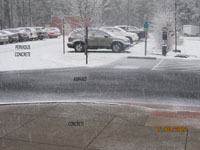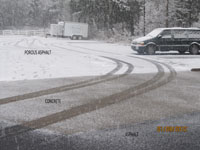| As part of Wetland Studies and Solutions, Inc.'s (WSSI) ongoing focus on sustainability and environmental design, we are constantly evaluating and often implementing new products and techniques at our headquarters facility in Gainesville, VA. During a 2008 parking lot retrofit, nearly 17,000 square feet (s.f.) of Gravelpave2 parking were converted to pervious concrete through a partnership with the Northern Virginia Concrete Advisory Council. This was followed more recently, in 2010, by the replacement of over 8,000 s.f. of gravel parking with porous asphalt in partnership with Chemung Contracting Corporation. These retrofits have allowed us to assess the functionality of each pervious system under a wide range of climatic conditions. |
Notable differences in pervious pavement performance have been documented at WSSI during precipitation events and freezing temperatures. As shown in the images to the right, pervious pavement areas tend to ice more quickly (when compared to adjacent areas of traditional concrete and asphalt) as temperatures drop below freezing and when sleet or freezing rain falls. The effect is similar to that displayed by highway bridges and overpasses and can create safety concerns if pedestrians or vehicles are caught unaware by the slick pervious surfaces – especially when the surrounding traditional surfaces have not yet frozen.
|
 |
| Pervious concrete vs traditional asphalt and concrete at WSSI. Click on image to enlarge.
|
|
| Research at the University of New Hampshire (UNH) has examined pervious concrete and porous asphalt performance in northern climates. This research found that the rapid drainage of pervious systems improved pavement durability by reducing freeze-thaw cracking and eliminated safety concerns associated with ice formation during refreezing. The added surface roughness of pervious systems was found to reduce braking distance when compared to similar conditions on traditional pavement. Appreciable reductions in seasonal salt application were also documented. The improved cold weather performance described in the UNH study and the early freeze observed at WSSI's office facilities can both be attributed to the high void ratio (increased air space) associated with pervious pavement. Though overall cold weather performance of pervious pavement is improved relative to conventional paving surfaces, in instances when air temperatures drop below freezing before ground surfaces, a "first-freeze" effect is created - as seen at our facility. This scenario is likely more common in the mid-Atlantic than further north where ground surface temperatures remain below freezing for much of the winter. The increased air space of pervious pavement systems reduces the buildup of latent heat and creates conditions where surface temperatures vary more widely with air temperature. The impact of this "air-cooled" effect may be an important consideration when specifying pervious systems, especially in the mid-Atlantic region. |
| Based on these observations, facility owners and site designers may want to consider including informational signage as part of pervious pavement designs. By specifying the placement of appropriate signage (similar to that seen on highway bridges and overpasses) the hazards of pervious pavement in freezing temperatures may be greatly reduced. Signage may also include educational information such as the role of pervious pavement in the water cycle and the benefits of infiltration.
|

Porous asphalt vs traditional asphalt and concrete at WSSI - Click on image to enlarge
|
|
| For more information on the pervious pavement options and other green building practices at WSSI, please visit our website or contact Bethany Bezak, Nathan Staley or Mike Rolband.
1 Houle, K.M., et. Al. (2010). Examinations of Pervious Concrete and Porous Asphalt Pavements Performance for Stormwater Management in Northern Climates. Proceedings from Low Impact Development 2010: Redefining Water in the City. American Society of Civil Engineers. |